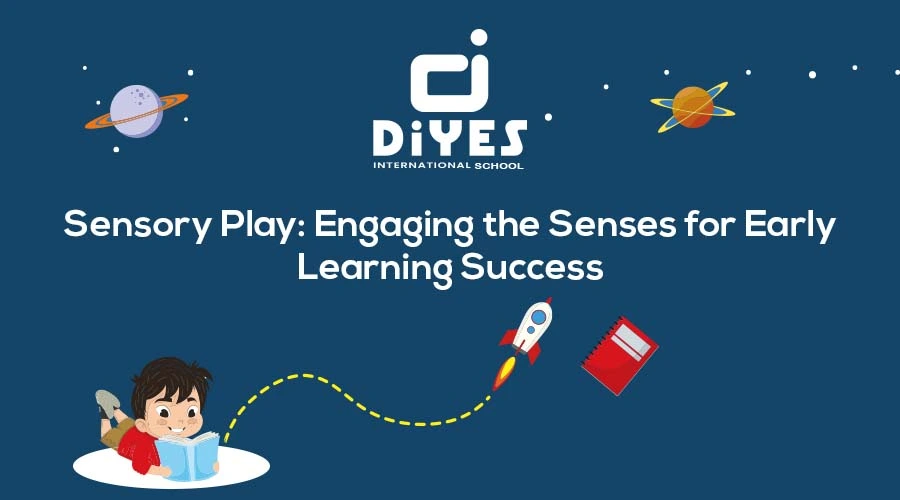Early childhood is a period of rapid growth and development, where young minds are like sponges, absorbing knowledge and experiences at an astonishing rate. At the heart of this transformative stage lies the power of sensory play. Sensory play involves activities that engage one or more of the five senses—sight, hearing, taste, smell, and touch. These activities stimulate a child’s brain, foster creativity, and lay the foundation for various cognitive, social, and emotional skills.
Sensory play is a vital component of early childhood education that fosters holistic development in young learners. This blog explores the significance of sensory play, its benefits, and various sensory activities that can be incorporated into early learning environments. Dive into the world of textures, colors, and sensations as we uncover how engaging the senses can set the stage for lifelong learning.
The Significance of Sensory Play
Sensory play is often viewed as mere child’s play, but its significance in early childhood development cannot be overstated. Beyond the surface fun and amusement, sensory play serves as a foundational pillar for the holistic growth of young children.
Why is Sensory Play Important?
Sensory play is a dynamic and engaging form of learning that involves stimulating a child’s senses – touch, taste, smell, sight, and hearing – to explore the world around them. While it may seem like playtime, sensory activities play a vital role in a child’s development for several compelling reasons. In this section, we will explore the profound importance of sensory play, shedding light on its multifaceted benefits that go far beyond entertainment.
- Expanding the Senses: Sensory play serves as a powerful catalyst for expanding and refining a child’s sensory perceptions. Through activities that involve touch, sight, sound, taste, and smell, children develop a heightened awareness of their surroundings. For example, immersing their hands in a bin of rice or sand helps them experience different textures and distinguish between them, fostering curiosity and a love for learning.
- Enhancing Cognitive Skills: Engaging the senses during play isn’t just about immediate sensory experiences; it has profound implications for cognitive development. Manipulating sensory materials involves problem-solving and critical thinking. For instance, building with blocks or moulding clay requires strategizing and adjusting actions based on sensory feedback, promoting cognitive flexibility. Moreover, sensory exploration strengthens memory and retention abilities, contributing to academic success.
- Emotional Regulation: Sensory activities provide a safe haven for emotional expression and self-regulation, nurturing emotional intelligence. Children experience a wide range of emotions during sensory play, from excitement to relaxation. Activities like squeezing a stress ball or finger painting serve as outlets for releasing pent-up energy or frustration. Sensory play encourages mindfulness and heightened awareness of emotions and sensations, equipping children with valuable self-regulation skills.
Benefits of Sensory Play
The world of sensory play is a treasure trove of developmental benefits that extend well beyond the realm of mere amusement. Sensory activities offer young children a diverse range of experiences that enrich various facets of their development. In this section, we’ll uncover the myriad advantages of sensory play and how they contribute to a child’s overall growth and well-being.

- Boosting Language Skills: Sensory play nurtures language development in young learners. Engaging in sensory activities compels children to describe their sensory encounters, enhancing vocabulary and communication skills vital in all aspects of life.
- Fine Motor Skills: Activities involving sensory materials are invaluable for fine motor skill development. Manipulating playdough, picking up small objects, or pouring sand strengthens hand and finger muscles, preparing children for everyday tasks and activities requiring precision, such as writing and crafting.
- Social Interaction: Sensory play fosters essential social skills through collaboration. Children learn cooperation, teamwork, sharing, respecting personal space, and listening to others. These interactions lay the groundwork for positive social relationships, effective communication, and conflict resolution.
- Problem Solving: Exploring sensory materials encourages children to become problem solvers. They encounter challenges that require creative thinking and decision-making. These experiences empower children with confidence, persistence, and a willingness to experiment, skills transferable to various aspects of life.
- Calming Effect: Sensory activities have a soothing effect, aiding in stress and anxiety management. Engaging in sensory play helps children regulate their emotions and provides a safe space to unwind and find emotional balance. This ability to self-soothe is an essential lifelong skill.
The benefits of sensory play are both diverse and profound. It boosts language skills, enhances fine motor skills, promotes social interaction, nurtures problem-solving abilities, and offers a calming effect. These advantages not only contribute to a child’s overall development but also equip them with a versatile set of skills and abilities that will serve them well throughout their lives. Sensory play, therefore, is an invaluable component of early childhood education.
Sensory Play Ideas and Activities
The allure of sensory play lies in its remarkable versatility. It opens up a world of possibilities for engaging young learners in meaningful and enjoyable experiences that stimulate their senses. In this section, we’ll delve into a variety of captivating sensory play ideas and activities, each designed to foster exploration, creativity, and sensory development.
- Texture Exploration: Texture exploration is a sensory adventure that captivates children’s tactile senses. Introduce various textures like smooth rice, crunchy beans, or soft shaving cream. Encourage them to touch and describe these materials, laying the foundation for sensory discrimination and language development.
- Sensory Bins: Sensory bins are havens of imaginative play. Create themed sensory bins with items like water, sand, or natural materials. These bins encourage storytelling, role-playing, and exploration, stimulating creativity and cognitive development.
- Sensory Art: Incorporate sensory elements into art activities to elevate creativity. Try finger painting, where they feel paint between their fingers, or textured collages with fabric scraps and sand. These activities encourage self-expression, fine motor skills, and an appreciation for the sensory aspects of art.
- Sound Exploration: Sound exploration introduces children to auditory sensations. Experiment with musical instruments like drums or xylophones. Nature sounds and water play enhances auditory senses, promoting sound discrimination and an appreciation for the auditory environment.
Sensory Play and Brain Development: A Powerful Connection
The relationship between sensory play and brain development is a fascinating and crucial one. Sensory play engages a child’s senses, including touch, taste, smell, sight, and hearing, in various stimulating activities. These experiences create a flurry of neural connections in the brain as it processes and makes sense of the sensory input. This process, known as sensory integration, plays a pivotal role in shaping a child’s cognitive, emotional, and social development.

When children engage in sensory play, their brains are hard at work, processing information and forming connections. For example, when a child explores the textures of different materials, such as the smoothness of clay or the graininess of sand, their brain is processing tactile information. This not only enhances their understanding of the physical world but also fine-tunes their motor skills as they manipulate these materials.
Moreover, sensory play encourages problem-solving and critical thinking. When children experiment with cause and effect during sensory activities, such as pouring water to see how it flows or mixing colours to observe the changes, they are engaging in cognitive exercises that promote analytical thinking.
Furthermore, the language centres of the brain are stimulated during sensory play as children describe the sensations and experiences they encounter. This enhances vocabulary development and language skills, which are vital for effective communication and literacy.
In essence, sensory play provides the brain with a rich tapestry of experiences, stimulating various areas of development simultaneously. As children explore, create, and experiment, their brains are forging pathways that enhance cognitive abilities, emotional intelligence, and social skills. Therefore, sensory play isn’t just about having fun; it’s about nurturing the developing brain and fostering holistic growth.
Incorporating Sensory Play into Early Learning Environments
Sensory play seamlessly integrates into early learning settings, enhancing the educational experience. Whether in a classroom or at home, these strategies can enrich the learning environment and promote sensory development.
- Designing Sensory Corners: Dedicating a corner of the classroom or home exclusively for sensory play creates a designated space for exploration. Equip it with a variety of sensory materials and activities that cater to different senses. This dedicated area not only encourages sensory engagement but also fosters a sense of ownership and routine, providing a comforting space for children to return to as they explore the world through their senses.
- Thematic Play: Aligning sensory play with the curriculum by creating sensory experiences related to ongoing themes or lessons enhances the educational journey. For instance, when studying marine life, provide a sensory bin with shells, sand, and water to simulate an ocean environment. This thematic approach not only reinforces learning but also allows children to immerse themselves in the subject matter, making abstract concepts more tangible and memorable.
- Outdoor Exploration: Expanding sensory play beyond indoor confines into outdoor spaces offers a wealth of opportunities for sensory-rich experiences. Nature provides a myriad of sensory stimuli, from the feel of soil in a garden to the sound of birds in the trees. Encourage children to explore the natural world through gardening, nature walks, or water play. These outdoor adventures not only stimulate the senses but also instill a deep connection with the environment and a love for the outdoors.
- Sensory Storytime: Enhancing storytelling by incorporating sensory elements adds a new dimension to the reading experience. Use props, scents, or textured pages in books to engage multiple senses while narrating a story. For instance, while reading a story about a forest adventure, bring in pinecones to touch, essential oils to smell, and recorded forest sounds to listen to. This multisensory approach not only makes storytelling more immersive but also promotes language development and comprehension skills, making the stories come alive in the minds of young readers.
- Cultivating Sensory Gardens: Transform outdoor spaces into sensory gardens, dedicated to exploring the natural world through touch, sight, smell, and sound. Plant a variety of flowers, herbs, and textured plants that children can interact with. Incorporate wind chimes, bird feeders, and water features to engage their auditory senses. Sensory gardens provide a unique opportunity for hands-on learning and sensory exploration in a natural setting, fostering a deeper appreciation for the environment.
- Sensory-Based Science Experiments: Integrate sensory experiences into science lessons by conducting sensory-based experiments. For instance, explore the concept of buoyancy by creating a sensory bin filled with water, oil, and objects of different densities. Or, investigate chemical reactions using safe, sensory-rich materials like baking soda and vinegar. These experiments not only teach scientific principles but also engage multiple senses, enhancing understanding and retention.
Incorporating sensory play into early learning environments can be a transformative experience. By dedicating spaces, aligning with curriculum themes, exploring the outdoors, enhancing storytelling, cultivating sensory gardens, and conducting sensory-based science experiments, educators and parents can create enriching educational settings that foster sensory development and holistic learning in young minds
Conclusion
In the vibrant world of early childhood education, sensory play stands as a beacon of holistic development. It is not merely child’s play but rather a profound educational tool that engages young minds, fuels their curiosity, and sets the stage for lifelong learning. Through sensory play, children expand their senses, enhance their cognitive skills, and learn to navigate the complex landscape of emotions.
The significance of sensory play extends far beyond the realms of amusement. It prepares children for academic success, fosters social interaction, nurtures problem-solving abilities, and equips them with essential skills for self-regulation. Sensory play is a cornerstone of early childhood education, providing the building blocks for a future filled with creativity, resilience, and a deep appreciation for the world around them.
In the quest to provide quality early education, institutions like DiYES International School have embraced the transformative power of sensory play. DiYES recognizes that sensory play is not just a recreational activity; it is a vital component of a well-rounded education.


By creating dedicated sensory spaces, aligning with curriculum themes, exploring the great outdoors, enhancing storytelling, and conducting sensory-based science experiments, DiYES International School ensures that every child’s sensory potential is nurtured and celebrated.
As we celebrate the wonders of sensory play, let us remember that it is not only about engaging the senses but also about igniting a lifelong passion for learning, exploration, and creativity. Sensory play empowers children to be active participants in their own education, laying the foundation for a future where they approach challenges with confidence, express themselves with eloquence, and embrace the world with open hearts and curious minds.


